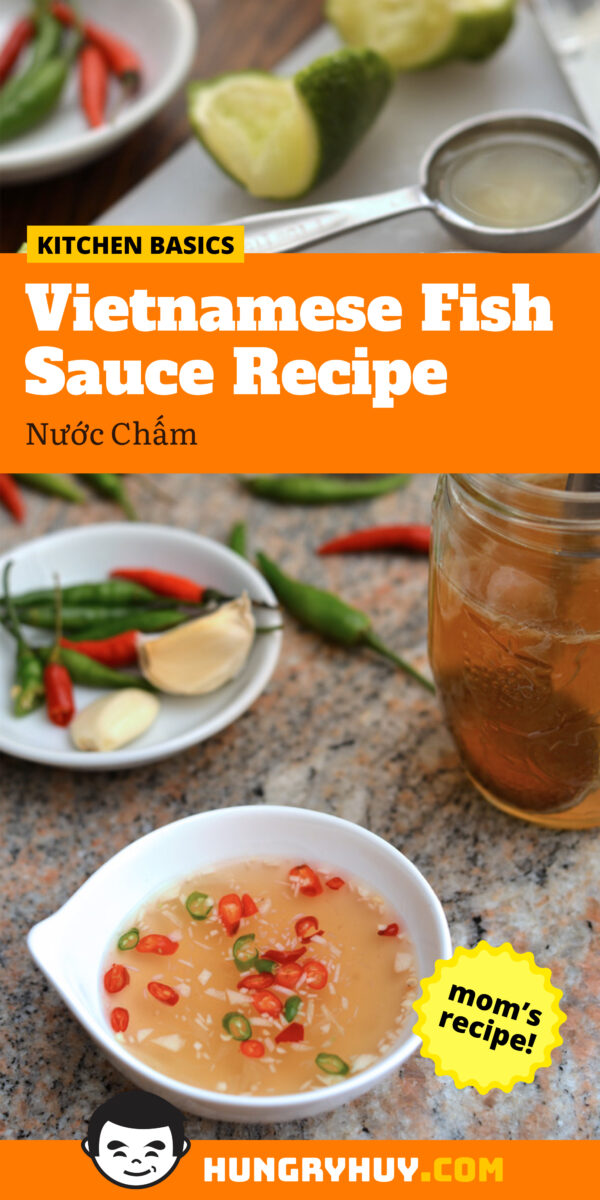Getting the hang of making this Vietnamese dipping sauce (nước chấm) is an important step to making your cuisine just right. Since it’s just about everywhere in Vietnamese cooking, it’s simply referred to as “dipping sauce”.
This is a dipping sauce I grew up with as a kid, with mom and grandma making this pretty often, for the dishes that specifically call for it, or sugarless versions of it just to dip boiled leafy veggies with (rau muống, or water spinach anyone?).
They’d keep a stash of premixed sauce ready in the fridge for regular meals throughout the week, but when a special dish is being made, they’d make a fresh batch for the meal or for the day, and it definitely tastes better.
I used the Three Crabs brand fish sauce. Depending on the kind you use, you will need to adjust the amount used due to sodium levels and flavor which can vary from brand to brand. This nước chấm or fish sauce recipe is all about making it to fit your taste.
What It’s Commonly Eaten With
There are many types of sauces Vietnamese people use for different foods, but this is the main sauce, primarily seasoned with fish sauce. You’ll usually find a bowl of this sauce next to many Vietnamese foods. For example…
Main dishes:
- bún thịt nướng (grilled pork with rice noodle and veggies)
- bánh xèo (savory Vietnamese crepes)
- bánh hỏi
- bánh cuốn
- sườn nướng (grilled pork chops, one of my favorites)
- fried fish, and many more!
Salad and rolls:
- Green Mango Salad with Shrimp (Gỏi Xoài)
- spring rolls or summer rolls
- chả giò (egg rolls)
For different dishes there are slight variations on nước chấm, but we will use this as a base recipe that works great for most things. You can adjust it to your own taste if needed depending on what it’s going with.
For example, local Vietnamese restaurants that sell roasted pork belly, will give you containers of this dipping sauce to go in styrofoam cups that are SUPER sweet, at least to my taste.
It verges on the realm of being syrup. But folks must love it for it to be the businesses’ mainstay. I love my sauces but there’s a point where it can obliterate the taste of the other ingredients in your recipe. This is to say that you should experiement with this recipe to land on ratios you like.
Ingredient notes
Water – Keep in mind that about half the volume of this sauce is water. So if you’re trying to conserve ingredients, or just not make so much that wouldn’t get used, know that the volume of water you start with, will be half of what you end up with in the final sauce.
Citrus – Start by mixing the water with sugar and lime or lemon. This is basically lemonade. If it’s too sweet, add some water. If it’s not sour enough add some more citrus. The flavor and acidity of lemon or limes can vary from fruit to fruit, so use your taste buds.
Following this recipe exactly each time can produce different results since limes or lemons can vary in liquid, pulp, acidity, etc.
But don’t even think about using bottled juice. That stuff tastes slightly muted, and missing that amazing fresh citrus oil scent that doesn’t stick around too long.
Fish sauce – Slowly add the fish sauce in increments until you gradually reach what the recipe calls for, all the while mixing the sauce and tasting it along the way.
After you get used to making this, you can start to tell by the color of the sauce when you are getting close.
Sugar – If you’re trying to dissolve sugar in cold water and it’s too cold it takes a lot longer to fully dissolve, and you can’t adjust ingredients as you go as accurately. Either use a small amount of hot or warm water enough to dissolve the sugar, then fill in the rest with cold or filtered tap water.
Or if you want to get fancy, make a simple syrup by heating equal parts sugar and water in a pot over medium heat until fully dissolved. If you use 1 cup sugar, 1 cup water, you’ll end up with about 1.5 cups of simple syrup. You can save the rest for making cocktails!
Optional additions – Add chopped chilies or finely chopped garlic to the sauce if you like. Chiles are a must for me, and garlic is nice too. Finely chopping garlic is a very time consuming task if you’re doing it manually.
If I’m doing it in bulk, I’ll throw them into a mini food processor, but if it’s just a few I love my garlic press as it’s a huge time saver, and easier to wash than the food processor.
If you live in a household in which each person is going to be picky about their nước chấm, having a mellow base dipping sauce is ideal for that. They can adjust in their own bowls if they want extra fish sauce, lime, sugar, chilies or garlic.
You can keep in an airtight jar in the fridge as you work through it, but I prefer to make it fresh for each meal.
Variations
Sometimes you’ll see people put their own twists on this recipe. It’s all about making it your own. I’ve seen some recipes that swap out sugar for some other juices.
In restaurants this is made in big batches. They’ll typically use vinegar for bite instead of lemons since it’s easier and cheaper.
Also, restaurants will not always want to bother finely chopping garlic for your dipping sauce. This is one you can easily add yourself at home.
If you’re looking to try this sauce out I recommend trying my recipe for Vietnamese grilled pork and rice noodle bowls. Let me know what you think about the sauce in a comment below, and thanks for reading!
Other common fish sauce questions…
What is in Vietnamese fish sauce?
Vietnamese fish sauce in its unadulterated form is made from anchovies, sea salt, and water. This is what you’ll typically find in bottles of fish sauce sold at supermarkets.
At Vietnamese restaurants, they also offer a dipping sauce made from fish sauce, water, sugar, citrus, and other optional ingredients like garlic or Thai chiles (like the recipe in this post!). This will be served in a small bowl on the side. If you see a bottle of this stuff on the side of your table, it is most likely the pure fish sauce they portioned out from a larger bottle.
What is nước chấm sauce?
Nước chấm is a Vietnamese dipping sauce that is made from a blend of fish sauce, water, sugar, and citrus (again, the same one you see in the recipe on this post!). You have the option of adding garlic or Thai chiles depending on your flavor preference. You can find this dipping sauce with dishes like chả giò (egg rolls), spring rolls or summer rolls, bánh xèo, bánh cuốn, bún thịt nướng (grilled pork with rice noodle and veggies), and more.
How do you make fish sauce from scratch?
How from scratch are we talkin? 🙂
Recently, I visited a fish sauce factory in Phu Quoc, Vietnam where most of the best fish sauce is produced to see how they made their fermented sauce. The basic ingredient list is anchovies, water, and sea salt, but the process and timeline to create such pungent sauce at home for a months-long project is difficult to achieve. To learn more about fish sauce, read my fish sauce post.
While people ask this, it’s more likely you’re trying to make the prepared dipping fish sauce-the one I have the recipe for below. I do, however, like making Nước chấm sauce at home using store bought fish sauce.
How long does nước chấm last?
While you can fridge nước chấm for about a week, I would recommend using it as soon as possible or making it fresh to enjoy the fresh zing of citrus that doesn’t last long. The flavor will lessen the longer it stays in the fridge.
Is hoisin sauce the same as fish sauce?
No, it’s very different. Fish sauce is made of anchovies, sea salt, and water, whereas hoisin is a thick sauce made from fermented soybean paste, sugar, garlic, and more. While fish sauce has a strong pungent flavor, hoisin has a blend of saltiness and sweetness.









![cham ngon anime Top 99 những Câu nói hay, ý nghĩa trong Anime [Quotes hay] châm ngôn anime](https://sachvui.co/wp-content/uploads/cham-ngon-anime.jpg)